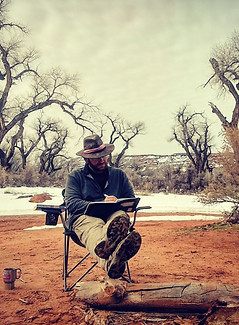R. E. Burrillo is an archaeologist and conservation advocate. He was the lead editor (with Ben Bellorado) of the 2018 Archaeology Southwest triple issue, Sacred and Threatened: The Cultural Landscapes of Greater Bears Ears. He lives in Salt Lake City, Utah.
So far, what’s been the most surprising (and/or difficult, and/or enjoyable) part about writing your book?
Just so far? Trying to juggle the different input variables from the different reviewers. The legal expert, the conservation expert . . . etc. etc.
Tell us about your dream book launch party.
It would be in Flagstaff, AZ and I would give a talk complete with projected images followed by a performance by my friend Ed Kabotie and his band The Yoties. We’ve actually done that once before, and it was a smash.
Describe one of your favorite places. What makes this place special to you?
Specifically? Grand Gulch. I described why it’s so special to me in a 2017 article in Blue Mountain Shadows, but to summarize: it’s the first place in Bears Ears I ever visited (back in 2006) and it’s where I spent the most time healing when I was sick for four years. It’s also ground zero for looking at the antagonistic virtues of protection versus visitation in Bears Ears as a whole.
Could you expand upon your background in regard to the Bears Ears?
I am an archaeologist, author, public scholar, and conservationist who hails originally from the East Coast, and has been studying and working on behalf of the cultural resources and descendent communities of the Bears Ears area since 2006. I am one of a very small handful of people that have conducted archaeological work on every major landform of the Bears Ears area: in the Beef Basin complex for the National Park Service; on Cedar Mesa and the surrounding lower upland areas for the BLM and University of Utah; in the Comb Ridge, Montezuma Creek, and Indian Creek areas for SWCA Environmental Consultants on behalf of the BLM; and in the Elk Ridge, Dark Canyon, and Abajo Mountain areas as an employee of the Forest Service. Most people specialize in, at most, one or two of those areas. This is a crucial component of my perspective on the area because of the “mosaic” nature of its human history.
What are you most looking forward to in 2020?
The end of the Trump Administration.
Why Torrey House?
For a long time, I didn’t even know “nonprofit publisher” was a thing. But I prefer doing all of my research and outreach work with nonprofits (like FCM and Grand Canyon Trust) because they keep their priorities focused on the topic or the mission rather than scrambling to meet profit margins in order to please shareholders.
"I didn’t even know “nonprofit publisher” was a thing. But I
prefer doing all of my research and outreach work with
nonprofits...they keep their priorities focused on the topic or
the mission rather than scrambling to meet profit margins."
Favorite Torrey House titles?
I’m really looking forward to reading the collection of Ellen Meloy’s unpublished material. I’m a big fan of hers!
Help bring Behind the Bears Ears by R. E. Burrillo to the page.
